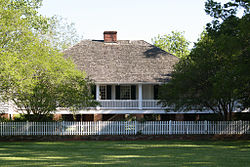Kent Plantation House is the oldest standing structure in Central Louisiana. Listed since 1971 in the National Register of Historic Places, Kent House is located in Alexandria in Rapides Parish. The plantation house is a representation of southern plantation life between 1795 and 1855. The main structure was erected in 1800 with the labor of people enslaved by Pierre Baillio. The bousillage Creole house and restored period outbuildings are now a showcase for tourists.[3]
Kent Plantation House | |
 | |
| Location | 3601 Bayou Rapides Road, Alexandria, Louisiana, USA |
|---|---|
| Coordinates | 31°18′22″N 92°29′01″W / 31.30611°N 92.48361°W |
| Area | 4 acres (1.6 ha)[1] |
| Built | 1800 |
| Architect | Pierre Baillio II |
| Architectural style | Greek Revival, Creole architecture |
| NRHP reference No. | 71000362 |
| Added to NRHP | August 5, 1971[2] |
History
editKent Plantation House displays original artifacts from people who worked and lived at the house during its operation.[4]
Buildings
editH. Parrott Bacot, former director of the Anglo-American Art Museum at Louisiana State University in Baton Rouge, Louisiana, led the interior restoration.[5]
The several outbuildings surrounding the main structure are furnished with Federal, Sheraton, and Empire pieces.[6]
The Milk House was built between 1820 and 1830; dairy products, such as cheese, milk, and butter, were prepared and stored there.[4] The Slave Cabin shows the primitive conditions in which the slaves at the plantation lived.[4] The Blacksmith Shop was constructed about 1815. The Kitchen contains an open hearth fireplace for cooking.
Marker Text
editThe marker at the front entrance of the Kent Plantation House reads:
Kent House, the oldest known standing structure in Rapides Parish, was built by Pierre Baillio, completed in 1800. Baillio constructed the house on land received through a Spanish land grant circa 1794.[7]
The house was actually built by enslaved people, not Ballio himself.[8]
See also
editGallery
edit-
Close-up of the plantation house
-
Visitor Center
-
Outdoor tour guide at Kent House
-
Milk House (constructed prior to 1830)
-
Various utensils inside the Milk House
-
Kitchen
-
Open-hearth cooking on the plantation; still done on a weekly basis by the Kent House staff
-
Laundry room
-
Barn at Kent House
-
Blacksmith shop
-
A wooden hammer
-
Cotton stalks at Kent House
-
Towering oak tree at Kent House
-
The center for the making of cane syrup at Kent House
-
Cane syrup in trough is ready for use.
-
Bottle tree, according to southern tradition, would ward off evil spirits.
-
Bousillage, a mixture of clay and grass, is a key building material of Kent House.
-
Indoor tour guide at Kent House
-
Dining table; the wooden fan from the ceiling was attached to a rope and powered by servants for cooling the room.
-
Parlor, where tea, an expensive item in that day, was served
-
Boys' bedroom
-
Girls' bedroom
-
Master bedroom
-
Bathtub in master bedroom
References
edit- ^ Sternberg, Mary Ann (June 30, 1993). The Pelican Guide to Louisiana (2 ed.). Firebird Press. p. 59. ISBN 978-0-88289-901-5.
- ^ "National Register Information System". National Register of Historic Places. National Park Service. March 13, 2009.
- ^ "Alexandria LA Historic Site - Kent Plantation House". Retrieved August 21, 2009.
- ^ a b c "Kent Plantation House - Alexandria, Louisiana". Louisiana Tourism. Archived from the original on May 9, 2009. Retrieved August 21, 2009.
- ^ DuFour, Darlene (1994). Kent House Alexandria, Louisiana. Pineville Louisiana: DD Management Corporation. p. 60.
- ^ "Kent Plantation House - Alexandria, Louisiana". MuseumRegister. Retrieved August 22, 2009.
- ^ "Kent Plantation House - Alexandria LA - Louisiana Historical Markers on Waymarking.com". Retrieved August 21, 2009.
- ^ Wilson, Samuel Jr. (August 5, 1971). "Inventory Nomination Form - Kent Plantation House". National Register of Historic Places. Retrieved October 6, 2021.
External links
edit- Kent Plantation House - official site

